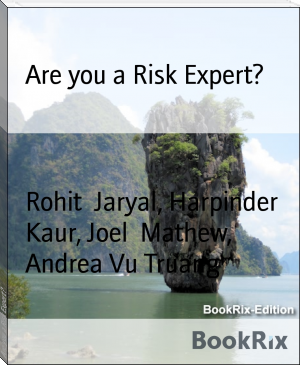Are you a Risk Expert? - Rohit Jaryal, Harpinder Kaur, Joel Mathew, Andrea Vu Truang (bill gates book recommendations txt) 📗

- Author: Rohit Jaryal, Harpinder Kaur, Joel Mathew, Andrea Vu Truang
Book online «Are you a Risk Expert? - Rohit Jaryal, Harpinder Kaur, Joel Mathew, Andrea Vu Truang (bill gates book recommendations txt) 📗». Author Rohit Jaryal, Harpinder Kaur, Joel Mathew, Andrea Vu Truang
Chapter 3: Identify the Risks
First step in Risk management process is to identify the risks. Ensuring timely risk identification is done is the sole responsibility of owner. The sooner risks are identified, sooner plans can be made to mitigate or reduce or manage the risks.
During risk identification whole project team must be involved. All potential risks identified should be recorded, regardless of whether it’s a small risk or big risk or the impact of risk.
Identification of Risks Can Be Done ThroughInterviews – interviews can be done selecting the key stakeholders. Specific questions can be asked, and the results of the interviews must be recorded and kept into records.
Checklists – the risks are to be noted down on a checklist. Then keep tracking throughout the process.
Brainstorming- Group of team members use this technique to forward ideas of risks.
workshops- workshops could be used to meet group of employees in order to identify the risks that could possibly impact the project and company.
Documentation review- in order to identify the risks, we can use the documents related to project such as lesson learned, articles and OPA.
Delphi technique- This is an anonymous way of getting the feedback or input from the team members. A set of information is given to the members, their responses are collected, and this process goes on till a consensus is reached.
SWOT analysis- strength, weakness, opportunities and threats are considered for the project and on these bases the risks are determined for the project.
Chapter 4: Risk ToleranceIn today's world a human being must take many decisions daily and it all depends on how that human being perceives risk. to access risk in business as well as personal life we calculate the amount of return which will be received upon happening of certain events and causes well in our favour.
Risk tolerance: Avoid or Accept?Tolerance is the limit of a particular object which it can achieve without any deformation in the same sense risk tolerance is the limit of risk which can be taken by an individual in the hopes of gaining more from his investment. It can be said that risk tolerance helps to understand the limitations of one person where he will decide how to deal with risk.
A person with a low level of risk tolerance can be termed as risk inverse. Risk tolerance describes how a person deals with risk. A person who has a low tolerance for risk will mostly try to avoid risk whereas a person who has a high level of risk tolerance accepts or partially accept the risk. This notion of risk acceptance is usually adopted by people who like to take calculated risks in the hope of multiplying their investment.
There are various advantages one can observe due to the classification of a person's risk tolerance as it describes their attitude towards risk. It helps to quantify risk and its related elements like rate of return, uncertain secondary risks, loss or damage and how to categorize them.
Chapter 5: Prioritizing the Risks
In this process, there is a prioritization of risks according to the situation, category. In every project, there is a possibility of occurring one or more risks at same time or different which creates major or minor problems in projects. When there is a limited resource in any project then the prioritization process of risks helps to make the stability in the project for better results.
Figure 3: (Giandomenico, 2018)
Prioritization of risks in project management needs some factors on which the prioritization depends
Risk prioritization by attitude
Risk prioritization depend on sensitivity
Risk prioritization according to resource availability
Risk prioritization depend on severity
In other words, we can say that prioritization depends on probability, impact, variability, impact.
Risk Impact assessmentRisk Assessment- how we can do that?
Risk Assessment is that process from which we can realize how much is the probability of occurring risk and we can assess the risk according to their probability that is from most occurring to least occurring risks or from high medium low. We can analyse the risk and evaluate the risk we can find that which risk is more harmful to the project and it helps to control the risks so that we can eliminate the risks before occurring. Risk analysis helps to determine the risk level and the information related to that risk includes data like this happened before in any project from the historical information asset.
Purpose of risk assessment-The main purpose of risk assessment is to mitigate the risk or control the risks and determine why the risk is happen or what are the effects of risks on project if happen or the possible risk is controllable or not with the recommend control measures.
Importance of Risk assessmentRisk assessment helps to make a list of harmful effects
It also determines that what control measures are needed to control the risks in the project and recommend if there is a need of more control measures.
At the planning stage or initiation stage, risk assessment helps to control or mitigate risks which prevent the project prior to implementation.
By assessing the risks, we can determine that our control measures is suitable for the project or not.
Method of risk assessmentIn every project, there is a risk prevention team which helps to identify the risks and recommend prevention measures.so, there is a method to





Comments (0)